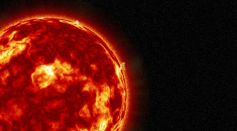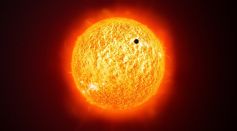Tags: Solar activity

Consecutive X-Class Solar Flares Erupt From Active Sunspot Cluster AR 3663 Facing Earth; Region May Stay Active Through May 8, With More Eruptions Expected To Happen
Solar Maximum May Have Already Started, But This Cannot Be Confirmed Until Solar Activity Calms Down Again

Aurora Alert? Intense X5-Class Solar Flare Bursted on New Year's Eve, Making It the Strongest in 6 Years

'Sunspot Archipelago' Stretches 200,000 Kilometers Across Solar Nearside; Dark Patch Region Releases Solar Flares at Alarming Rate With Earth To Be at Its Firing Line
Solar Activity To Become Stronger As Sun Approaches Maximum Cycle; Northern Lights Will Be More Frequent in 2024

Northern Lights Extravaganza: More Aurora Displays Expected in the Next Four to Five Years

India’s First Mission to the Sun: Aditya-L1 Successfully Launches
Powerful Solar Outburst Hit Earth, Moon, Mars for the First Time [Study]

Vibrant Green Aurora-Like Streaks of Light Illuminating the Night Sky Could Become More Common as the Sun’s Activity Continues to Ramp Up

Monstrous Sunspot Unleashed the Carrington Event, History's Most Destructive Solar Storm

Stunning Solar Close-Up Images Taken by Daniel K. Inouye Solar Telescope Showcase Intricate Details of the Sun

Massive Solar Flare Directly Hitting Earth Today: NOAA Issues Geomagnetic Storm Watch
Mars Missions Should Not Exceed 4 Years To Protect Astronauts Health, Space Equipment From Harmful Particles, Radiation
Solar Storms Mystery Finally Solved: Simulation Model to Predict Space Weather, Geomagnetic Storms Developed

Extreme Solar Activities Detected Through Tree-Ring Dating Back From 5,410 BCE
Intense Solar Activity Is Bringing the Northern Lights To the United States
What is the Solar Cycle 25?
Solar Activity Impacts Climate More During “Cool Periods”
Most Popular

Space Tourism Future: How Commercial Space Travel Will Transform Civilian Exploration

Tree Communication Explained: How Underground Fungi Networks Connect Entire Forests

Universe Origin Revealed: Exploring the Latest Big Bang Science Theories and Discoveries

How Space Observation and the Solar Light Spectrum Make the Sun Look Different in Space Than on Earth





